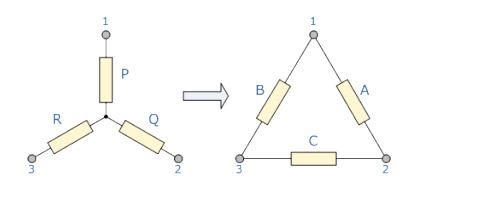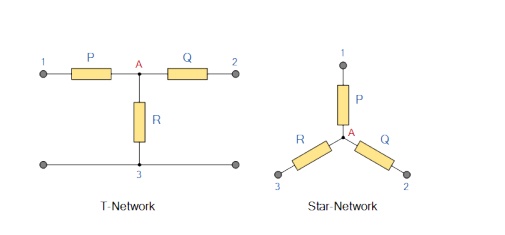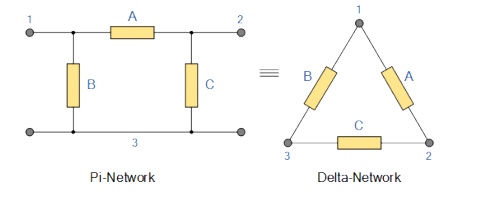Chapter: Basic Electrical and electronics : Electric Circuits and Measurements
Star Delta transformation
Star Delta transformation:
Star to Delta transformation:

Star Delta Transformations allow us
to convert impedances connected together from one type of connection to another. We can now solve simple series, parallel
or bridge type resistive networks using Kirchhoff´s Circuit Laws, mesh current
analysis or nodal voltage analysis techniques but in a balanced 3-phase circuit
we can use different mathematical techniques to simplify the analysis of the
circuit and thereby reduce the amount of math’s involved which in itself is a
good thing.
Standard
3-phase circuits or networks take on two major forms with names that represent
the way in which the resistances are connected, a Star connected network which has the symbol of the letter, ÎĄ (wye)
and a Delta connected network which
has the symbol of a triangle, (delta).
If a
3-phase, 3-wire supply or even a 3-phase load is connected in one type of
configuration, it can be easily transformed or changed it into an equivalent
configuration of the other type by using either the Star Delta Transformation or Delta
Star Transformation process.
A resistive network consisting of three impedances can be connected together to form a T or “Tee” configuration but the network can also be redrawn to form a Star or Υ type network as shown below.

As we
have already seen, we can redraw the T resistor network to produce an
equivalent Star or Υ type network. But we can also convert a Pi or π type
resistor network into an equivalent Delta or type network as shown below.
Pi-connected
and Equivalent Delta Network.

Having now
defined exactly what is
a Star and Delta connected network
it is possible
to transform the ÎĄ into an equivalent circuit and also to convert a into
an equivalent ÎĄ circuit using a the transformation process. This process
allows us to produce a mathematical relationship between the various resistors
giving us a Star Delta Transformation
as well as a Delta Star Transformation.
These Circuit Transformations allow us
to change the three connected resistances (or impedances) by their equivalents
measured between the terminals 1-2, 1-3 or 2-3 for either a star or delta
connected circuit. However, the resulting networks are only equivalent for
voltages and currents external to the star or delta networks, as internally the
voltages and currents are different but each network will consume the same amount
of power and have the same power factor to each other.
The value
of the resistor on any one side of the delta, network is the sum of all the
two-product combinations of resistors in the star network divide by the star
resistor located “directly opposite” the delta resistor being found.
For
example, resistor A is given as:
A= (PQ +
QR + RP) / R with respect to terminal 3 and resistor B is given as:
B = (PQ + QR + RP) / Q with respect to terminal 2
and resistor C given as:
B = (PQ +
QR + RP) / R with respect to terminal 1.
By
dividing out each equation by the value of the denominator we end up with three
separate transformation formulas that can be used to convert any Delta
resistive network into an equivalent star network as given below.
Star Delta Transformation allows us
to convert one type of circuit connection into another type in order for us to easily analyze the circuit and star delta
transformation techniques can be used for either resistances or impedances.
One final
point about converting a star resistive network to an equivalent delta network.
If all the resistors in the star network are all equal in value then the
resultant resistors in the equivalent delta network will be three times the
value of the star resistors and equal, giving: RDELTA = 3RSTAR
Delta to Star Transformation

Compare
the resistances between terminals 1 and 2.
P+Q= A in
parallel with (B+C)
P+Q =
A(B+C) / A+B+C……………….(1)
Resistance
between the terminals 2 and 3.
Q+R = C
in parallel with (A+B)
Q+R=C(A+B)
/ A+B+C……………….(2)
Resistance
between the terminals 1 and 3.
P+R = B
in parallel with (A+C)
P+R =
B(A+C) / A+B+C………………(3)
This now
gives us three equations and taking equation 3 from equation 2 gives: P+R-Q-R =
(B(A+C)) –( C(A+B) ) / A+B+C
P-Q =(BA
+ BC – CA – BC) / A+B+C P-Q = BA – CA / (A+B+C)…………….(4)
Then,
re-writing Equation 1 will give us:
P+Q =
(AB+AC) / A+B+C …………………….(5)
Equ (4) +
Equ (5)
P+Q+ P-Q
= (AB+AC) / A+B+C + (BA – CA) / A+B+C 2P = (AB+AC+BA-CA) / A+B+C
2P = 2AB
/ A+B+C P = AB / A+B+C
Then to
summarize a little about the above maths, we can now say that resistor P in a
Star network can be found as Equation 1 plus (Equation 3 minus Equation 2) or
Eq1 + (Eq3 – Eq2). Similarly, to find resistor Q in a star network, is equation
2 plus the result of equation 1 minus equation 3 or Eq2 + (Eq1 – Eq3) and this
gives us the transformation of Q as:
Q = AC /
A+B+C
and
again, to find resistor R in a Star network, is equation 3 plus the result of
equation 2 minus equation 1 or Eq3 + (Eq2 – Eq1) and this gives us the
transformation of R as:
R = BC /
A+B+C
When
converting a delta network into a star network the denominators of all of the
transformation formulas are the same: A + B + C, and which is the sum of ALL
the delta resistances. Then to convert any delta connected network to an
equivalent star network
If the
three resistors in the delta network are all equal in value then the resultant
resistors in the equivalent star network will be equal to one third the value
of the delta resistors, giving each branch in the star network as: RSTAR
= 1/3RDELTA
Related Topics